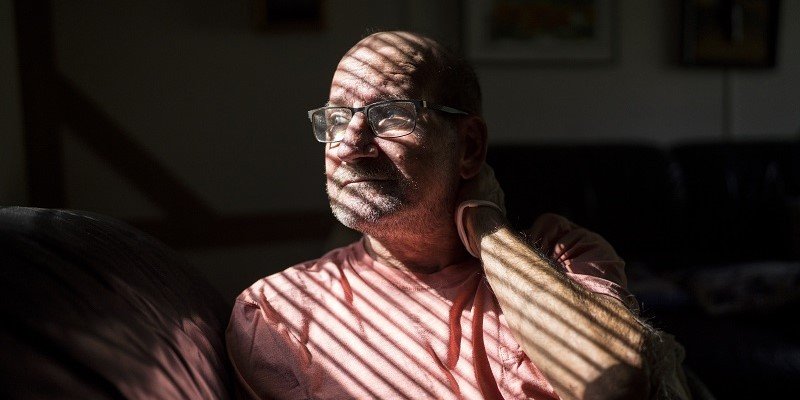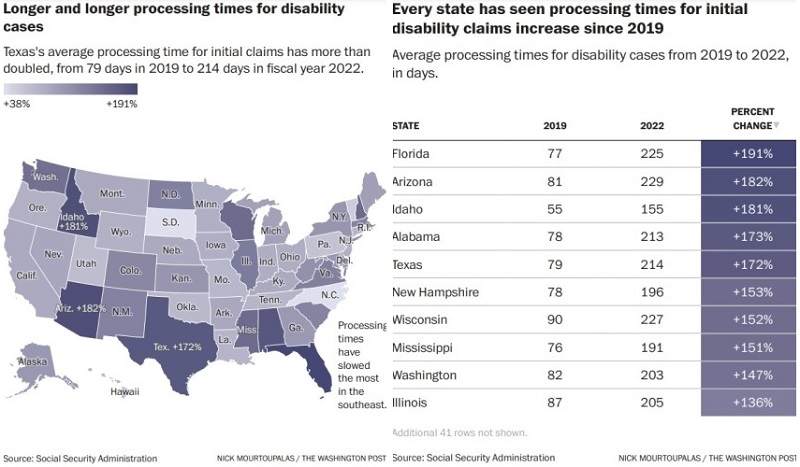
Dale Pearson, left, and Sandra-Kay Pearson rest in their car on Nov. 17, 2022, outside a hospital in Knoxville, Tenn., where Dale is receiving treatment for a heart condition.
13:25 JST, December 6, 2022
The Disability Determination Division in Austin was at a breaking point.
Inside its vast two-story warehouse, close to 130,000 claims were awaiting review by the state employees who help decide whether Texans will get disability benefits from the Social Security Administration – a backlog that would take at least a year to clear. Nearly 40 percent of the examiners had quit since January, driven out by crushing workloads and low wages that could not compete in the high-tech boomtown. Those who stayed toiled in long rows of cubicles or at home reviewing massive medical files.
Then one week in September came the unthinkable: 75,000 new claims suddenly were routed to an electronic queue already buckling under 21/2 years of strain during the coronavirus pandemic.
“I wanted to help people,” recalled Shayla Williams, who worked in the office for two years until she quit in February. “But I was miserable. I’m getting paid $17.50 an hour to play doctor all day. It was not worth it.”
The avalanche of new cases was one more reminder that the forgotten bureaucracy in the Texas state government off Interstate 35 had broken down, a failure that has left thousands of poor, disabled and increasingly desperate people without the benefits they need to survive, according to advocates and claimants.
The same system has collapsed in many of the other state offices where Social Security has outsourced reviews of disability claims – a decentralized, convoluted structure Congress created nearly seven decades ago to let low-paid state employees rule on who should get federal benefits.
Now more than a million Americans wait in limbo just to hear whether they will get assistance – the first step in a system of drawn-out judgments and appeals that can ultimately take years before a resolution. The record number of claims awaiting an initial ruling jumped almost 60 percent from before the pandemic. Those denied but under second review rose by 75 percent, Social Security data shows.
The data obtained by The Washington Post paints a grim picture of the holdups claimants are confronting across the country. In Texas, it took 214 days on average in fiscal 2022 to process an initial application. Wisconsin took 227 days, up from 90 days in fiscal 2019. Florida’s average time has almost tripled to 225 days. Georgia is taking 246 days. And Delaware now holds the record for the longest wait: 261 days. The pileup of cases has driven a normally three-month wait for an initial review to at least seven, the data shows. But in states struggling most to catch up, it’s taking well over a year.
As they wait, some Americans already living at their limits have found themselves with fewer resources, worsening medical conditions and no access to the health insurance that comes with disability benefits. Sandra-Kay Pearson, a 59-year-old former phlebotomist in Greenville, S.C., and her disabled husband are living out of their Nissan Rogue as they await a second ruling on her request for benefits, filed 15 months ago. They sleep in the vehicle after shuttling between parking lots in Greenville and Knoxville, Tenn., where he is receiving treatment for a heart condition.

Sandra-Kay Pearson heats up a meal for her husband at a Kroger grocery in Knoxville, Tenn., on Nov. 17, 2022. Pearson, 59, and her disabled husband are living out of their vehicle as they await a second ruling on her request for benefits, filed 15 months ago.
“If they’re going to reject me, go on and reject me so I can get before a judge,” Pearson said. Like 2 in 3 claimants, she was denied on the first try. If she loses again, she says she’ll file for a hearing before the administrative law judges who hear most final appeals.
The state offices lost ground even as the number of poor disabled and elderly people asking for government help plunged during the pandemic – the result, experts say, of the protracted closures of local Social Security field offices this population relies on.
Behind the delays lie years of financial neglect and mismanagement in a system whose flaws were only amplified by the public health crisis, according to 33 examiners and state directors, former Social Security officials, claimants, disability attorneys and advocates for the disabled in 10 states who spoke for this story. Perennial hiring and pay struggles, staff shortages, obsolete technology, and fault lines between the states and federal officials have all contributed to the crisis.
“The states have always struggled,” said Brian Nickles, who retired a year ago as director of the Oklahoma office of Disability Determination Services. “They’re Social Security’s bastard stepchild. The pandemic just exposed the problems.”
Social Security officials said they are working to break the logjam by collaborating with states to approve money for vacant jobs; improving hiring strategies, retention and training; and paying overtime. The agency also is sending reinforcements to struggling states to help process claims.
Acting Social Security commissioner Kilolo Kijakazi declined to be interviewed for this story. In a statement, she said: “We are analyzing factors that are contributing to the backlog. It is a combination of complex issues.” She cited challenges to hiring in the tight labor market, “historically high attrition” in the state offices, increasing medical evidence that must be reviewed, and shortages of physicians to conduct outside medical exams and review cases.
Kijakazi said she is counting on Congress to pass President Biden’s full budget request for fiscal 2023, “so that we can continue these efforts and begin to improve service to the people who are counting on us.”
State leaders, meanwhile, largely deflect blame to Washington. “This is a national program,” said Anne Mayo, South Carolina’s director of Disability Determination Services, when asked why her office is taking 249 days on average to process a claim. “It’s Social Security’s program. We follow their policies and procedures.” Political sensitivities around the backlog are so intense that the national organization representing disability examiners declined to comment on the record.
The job has become “untenable” in many states, a spokeswoman for Michelle Schroeder, Wisconsin’s disability determination director, said in an email.
Without drastic change, the disability system’s struggles could worsen. Auditors at the Government Accountability Office warned this year that with 80 million aging baby boomers at risk of disabling conditions, the potential for chaos could grow, particularly as the pandemic added a “new and unprecedented challenge” to Social Security’s mission.
“They could have been more responsive,” Scott Panckeri, acting director of Pennsylvania’s Bureau of Disability Determination, said of Social Security. “They erred on the side of caution, and it was to the detriment of some states. When you have a once-in-a-lifetime pandemic, you need to be a little more creative.”
***
Congress paved the way for the current crisis in the 1950s, when lawmakers created the first of two federal benefit programs for people with disabilities. The complex vetting system was meant to ensure the government served only those who qualified. In an appeal to conservatives, each state was given primary responsibility for reviewing claims – along with offices in Puerto Rico and D.C. – creating jobs and devolving power from Washington. The system created an uneasy balance of power.
“You’re trying to run a federal agency out of the states,” said Melissa Spencer, a former deputy associate commissioner for Social Security’s Office of Disability Policy. “The politics and tensions have always been complicated.” Policymakers for years have suggested in frustration that federal employees take over.
The partnership was often tenuous, and the pandemic frayed it more. The states’ costs are reimbursed by Social Security, which sets policies and regulations and determines when states can hire. The states train employees, set salaries and award benefits at rates that vary wildly. Social Security must sign off when a state wants to give its workers a raise.
Starting pay for examiners varies from $16,128 in Puerto Rico to $75,506 in D.C., an outlier. Florida pays $32,655 and Minnesota, $47,899. If Social Security doesn’t have money, jobs can go unfilled. Even when funding is available, hiring freezes at the state level can leave them vacant.
The job itself was always too complex for the pay, say those still doing it and others who’ve left. Examiners must review hundreds of pages of a claimant’s medical records and work history. Yet they are not trained as medical experts – and in some states don’t even need college degrees.
New hires go through time-consuming background checks. Fully learning the job takes two or three years. And in recent years the work grew tougher: Now more evidence is required to back up a claim, and by 2020 the average number of pages in a case file had grown to 940 from 160 a decade earlier, federal auditors found.
“It’s one of those jobs where a lot of people jump into it, and they don’t realize what they have to do and how hard it is,” said Logan Mrozenski, who left the disability office in Madison, Wis., after 18 months because, he said, “I didn’t want to be a bureaucrat.”
When the pandemic hit in early 2020, most of the 14,400 state employees were sent home. Social Security barred some offices from taking desktop computers home, effectively closing down operations for months until laptops could be ordered and distributed. The states had been fighting for more than a decade for Voice over Internet Protocol technology to speed up customer service, but Social Security had not delivered.
“Everyone’s numbers took a hit,” recalled Mrozenski, who dismantled his desktop computer and monitor, lifted them into an empty laundry basket and drove them to his apartment to keep working. Technology challenges forced nine states to suspend operations during the transition, auditors found.
In Texas and other states, teleworking staffs were ordered to use their private phones. They were not reimbursed for the cost of their plans. Pennsylvania ordered 600 flip phones that took months to arrive – but many claimants wouldn’t answer calls because they thought they were coming from spam numbers. “I was really taken aback by how limited the technology was at the DDS,” Ian Harlow, who ran the state’s disability determination office from 2020 until early this year, told Social Security’s advisory board at a forum last year.
In most offices, the situation grew only more chaotic. Claimants were seeing fewer doctors, leaving examiners with the vexing task of documenting their 12-month medical histories. Retrieving records from medical offices whose employees were furloughed or working remotely took months. And when records arrived, they were often stale: Some people had developed new conditions requiring treatment that then needed review.
States confronted an exodus of examiners and physicians, both contractors paid to examine claimants and staff who make final decisions on benefits. Cases left behind were redistributed and sent to the back of the queue. Or long waits for a doctor’s sign-off would delay decisions.
Hiring stalled as states faced the repercussions of decades without competitive wages. Trainees would make it through months of instruction only to quit. In desperation, some states brought on even less qualified people, a further drag on productivity. A growing number of examiners went out on mental health leave, citing the stress of the job.
Yet instead of easing the mounting delays, Social Security’s decisions in Washington made the situation worse on the ground in many states.
Coronavirus concerns led the agency to tell states to suspend exams by outside doctors for two months, jamming the system. It was not until the fall of 2020 that all states had resumed in-person exams.
Nine states from Ohio to California mandated furloughs, and Social Security was able to persuade just three to exempt their disability staffs. Caseloads soared. Examiners who had normally juggled 70 to 100 cases saw their numbers double.
***
Yet just as employees struggled to keep up, Social Security threw down a fresh gauntlet: a new case-processing system to track claims. The $153 million investment, facing years of delays, was supposed to improve customer service and save money. An initial rollout in 2019 hit glitches with functionality. The effort restarted in late 2021, but the timing was perilous.
States had tailored the old systems to their needs, and the new one not only took months for many employees to learn but also had limited options. State directors blame Social Security for an ill-timed rollout they say resulted in severe delays to processing claims.
“We had a devil of a time trying to get a handle on it,” said Basil Merenda, a deputy secretary for Pennsylvania’s Department of Labor and Industry, the parent agency of the disability determination office. “We still have nightmares.”
Across the country, a bug prevented outside doctors from being paid for months.
“The old system had been customized over decades to maximize efficiency for our examiners and meet Wisconsin’s specific needs,” the Wisconsin spokeswoman wrote. In Austin, a spokeswoman for Mary Wolfe, administrator of the Texas office, blamed shortcomings with the new system for the 75,000 cases that appeared in the queue in September. The claims had sat unopened for six months.
For the workforce left behind, the mission of helping the poor and disabled soon collapsed into the dreariness of an assembly line.
“It became up to me to pretty much figure out by myself if this person was disabled or not,” said one examiner who lasted 18 months in Austin, making $41,000, before leaving in May, and who spoke on the condition of anonymity out of fear of retribution from her former bosses. “I would walk in there, and it was like there was a weight on my shoulders. The support just wasn’t there.”
A former examiner in Florida, explaining why he quit in September after 12 years, described the job this way: “It was all about the numbers. It was the sheer amount of work. We didn’t care if you were denied or approved, we just wanted the cases out.”
For claimants desperate to learn if they will be approved for benefits or have to start the torturous appeal process, the delays have been devastating. If they or their lawyers can get through on the phone, the operator can’t tell them the status of their case until, like the 75,000 claims in Texas, it has been assigned for review.
“We don’t even have someone to go to ask, ‘What’s happened to this person’s case?’ ” said Melanie Kohut, a legal assistant for a disability practice in Decatur, Ga.
In Florida, QuikAid, a large-volume disability firm, has 11,000 pending claims, up from 3,000 in a typical year, chief executive David Wright said. One of them is Rusty Swain’s. Swain, 59, was a commercial electrician in Tampa when a collision with an I-beam on a construction site 10 years ago left him with severe neck and back injuries. After several surgeries, he has lost the use of his right arm and suffers from arthritis in his neck. He can no longer work anything but occasional small jobs, he said. He lives in a small trailer as he waits for a ruling on his claim, which has been pending for a year.
“I’ve done nothing but physical labor since I was 15,” Swain said. “I’m not a slacker. I pay taxes. I just need disability insurance.”

Rusty Swain, 59, in Brooksville, Fla., on Nov. 28, 2022. Swain has neck and back injuries from a job-related accident 10 years ago. His disability claim is has been pending for a year.
State offices confronting the mounting claims say there are few obvious solutions. Social Security says it has agreed to a surge in new hires, but the hot labor market may stall those efforts if higher salaries don’t come with it. A quarter of examiners quit or retired this year, double the number two years ago.
South Carolina recently was able to hire into just 24 of 50 open positions, Mayo, the state director, said in an email through the Social Security public affairs office. So many doctors left that she tried for the first time to recruit nurses to complete medical evaluations, according to March 2021 minutes of the state Vocational Rehabilitation Department, the disability division’s parent agency. It is unclear if she succeeded.
To stanch its losses, Oklahoma officials advertised last year for 100 examiner jobs. “We got 70 applications,” recalled Nickles, the retired disability determination director. “We weren’t getting the best of the best. In the grand scheme of things, it’s a low-paying job.” Some directors tried for bonuses and raises, but each was a struggle, dependent on governors and Social Security.
Social Security officials said they have “approved all [state] salary increase requests that meet the necessary and allowable costs.”
But some state officials dispute that. Wolfe pleaded with Social Security officials for three years for higher starting pay for examiners in Texas, her spokeswoman said, because she could not attract them in a city where the median home price is now $640,000.
Social Security denied her request “multiple times” before finally relenting in July.
In July, Texas gave starting examiners a $16,800 raise to $55,000 – the first significant increase since 2006.
But Austin continues to hemorrhage staff. While examiners went without pay boosts, they watched Wolfe get a raise of approximately $5,200 during the pandemic, rubbing salt in the wound, several examiners said. “While working to address equity pay, managers were encouraged and authorized to continue awarding merit increases and career path raises to all eligible [DDS] employees,” the spokeswoman for Wolfe said. The docket for veteran examiners has grown to a record 19 claims a week, several current employees said. They’re juggling 217 cases at once.
To boost morale, the office had long given examiners a “golden ticket week” with no new cases, a chance to regroup and work on old ones. The practice ended in the pandemic and has not been restored.
“The workplace environment was just so difficult to be in,” said Stephanie Koenig, who worked in the Texas office for two years. She quit in 2021 to work at a position in public health that pays her 20 percent more.

"News Services" POPULAR ARTICLE
-

American Playwright Jeremy O. Harris Arrested in Japan on Alleged Drug Smuggling
-

Japan’s Nikkei Stock Average as JGB Yields, Yen Rise on Rate-Hike Bets
-

Japan’s Nikkei Stock Average Licks Wounds after Selloff Sparked by BOJ Hike Bets (UPDATE 1)
-

Japanese Bond Yields Zoom, Stocks Slide as Rate Hike Looms
-

Japan’s Nikkei Stock Average Buoyed by Stable Yen; SoftBank’s Slide Caps Gains (UPDATE 1)
JN ACCESS RANKING
-

Keidanren Chairman Yoshinobu Tsutsui Visits Kashiwazaki-Kariwa Nuclear Power Plant; Inspects New Emergency Safety System
-

Imports of Rare Earths from China Facing Delays, May Be Caused by Deterioration of Japan-China Relations
-

University of Tokyo Professor Discusses Japanese Economic Security in Interview Ahead of Forum
-

Japan Pulls out of Vietnam Nuclear Project, Complicating Hanoi’s Power Plans
-

Govt Aims to Expand NISA Program Lineup, Abolish Age Restriction



















